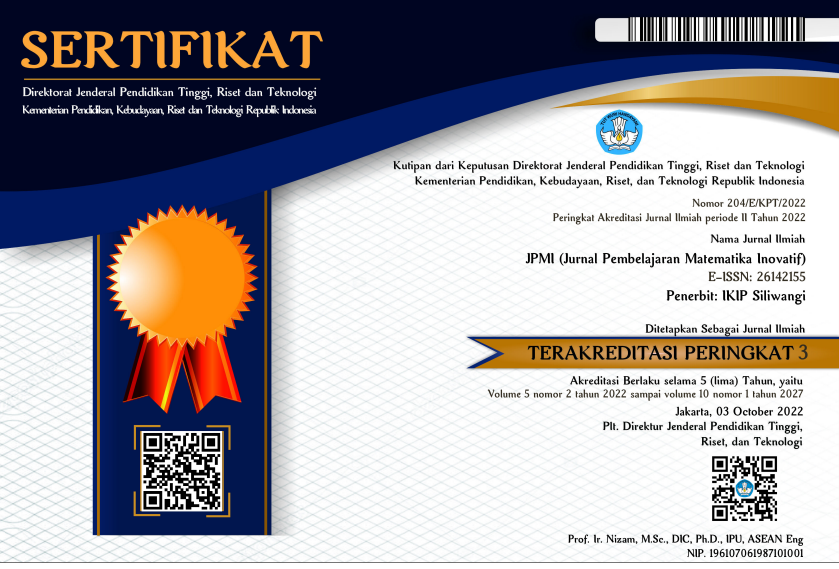LITERASI MATEMATIKA CALON GURU SEKOLAH DASAR DALAM MENYELESAIKAN MASALAH PISA KONTEN SHAPE AND SPACE
DOI:
https://doi.org/10.22460/jpmi.v3i3.p%25pKeywords:
Mathematical Literacy, PISA, Pre-Service Teacher, Elementary SchoolAbstract
Mathematical literacy is an ability that is needed by students in this changing era. Mathematical literacy can be seen from the ability to formulate contextual problems mathematically; using facts, concepts, and mathematical procedures; as well as interpreting and evaluating mathematical outcomes well. One of the factors that cause students' good mathematical literacy is teacher's good mathematics literacy. The purpose of this study is to describe the mathematical literacy abilities of pre-service elementary school teacher in solving PISA problems about shape and space. This research method is qualitative-descriptive. The subjects of the study were pre-service elementary school teachers, each with high, medium, and low cognitive abilities. The results showed that high-ability pre-service teacher were able to demonstrate good mathematical literacy performance, which was able to fulfil all three aspects namely formulating mathematical problems; use mathematical concepts and procedures well; and interpret mathematical answers well in the context of the problem. Medium-ability pre-service teachers are not able to meet several indicators on aspects of formulating problems and using mathematical concepts and procedures. Low-ability pre-service teachers cannot fulfil all indicators on aspects of using mathematical concepts and procedures properly.
References
Astuti, N. K., Fahinu, & Masuha, J. (2018). Analisis Kemampuan Literasi Matematika Siswa Kelas VIII SMP Swasta di Kota Kendari. Jurnal Penelitian Pendidikan Matematika, 6(1), 99–112.
Disnawati, H. (2018). Literasi Mahasiswa: Analisis Kemampuan Matematika Calon Guru Di Wilayah Perbatasan Indonesia – Timor Leste. KNPMP III 2018, 773–779. Program Studi Pendidikan Matematika FKIP UMS.
Dores, O. J., & Setiawan, B. (2019). Meningkatkan Literasi Matematis Mahasiswa Calon Guru Sekolah Dasar dalam Membelajarkan Matematika. Jurnal Pendidikan Matematika Indonesia, 4(1), 42–46.
https://doi.org/http://dx.doi.org/10.26737/jpmi.v4i1.861
Fathani, A. H. (2016). Pengembangan Literasi Matematika Sekolah dalam Perspektif Multiple Intelligences. Jurnal EduSains, 4(2), 136–150.
Hayati, T. R., & Kamid, K. (2019). Analysis of Mathematical Literacy Processes in High School Students. International Journal of Trends in Mathematics Education Research, 2(3), 116–119. https://doi.org/10.33122/ijtmer.v2i3.70
Hendroanto, A., Istiandaru, A., Syakrina, N., Setyawan, F., Prahmana, R. C. I., & Hidayat, A. S. E. (2018). How Students Solves PISA Tasks: An Overview of Students’ Mathematical Literacy. International Journal on Emerging Mathematics Education, 2(2), 129–138. https://doi.org/10.12928/ijeme.v2i2.10713
Julie, H., Sanjaya, F., & Anggoro, A. Y. (2017). The Students’ Ability in Mathematical Literacy for The Quantity, and The Change and Relationship Problems on The PISA Adaptation Test. Journal of Physics: Conference Series, 890(012089), 1–6. https://doi.org/10.1088/1742-6596/890/1/012089
Karmila. (2018). Deskripsi Kemampuan Literasi Matematis Siswa Ditinjau dari Gender. Pedagogy, 3(1), 126–137.
Khotimah, K., & Nasrulloh, M. F. (2018). Kemampuan Literasi Mahasiswa dalam Menyelesaikan Masalah Matematika Ditinjau dari Gaya Belajar Global dan Kemampuan Matematika. Prosiding Silogisme Universitas PGRI Madiun, 8–14. Retrieved from http://prosiding.unipma.ac.id/index.php/PSNPM/article/view/598
Mahdiansyah, & Rahmawati. (2014). Literasi Matematika Siswa Pendidikan Menengah: Analisis Menggunakan Desain Tes Internasional dengan Konteks Indonesia. Jurnal Pendidikan Dan Kebudayaan, 20(4), 452–469. https://doi.org/10.24832/jpnk.v20i4.158
Masjaya, & Wardono. (2018). Pentingnya Kemampuan Literasi Matematika untuk Menumbuhkan Kemampuan Koneksi Matematika dalam Meningatkan SDM. PRISMA, Prosiding Seminar Nasional Matematika, 1, 568–574.
Maulyda, M. A., Hidayati, V. R., Nur, A., & Rosyidah, K. (2019). Problem-solving ability of primary school teachers based on Polya ’ s method in Mataram City Problem-solving ability of primary school teachers based on Polya ’ s method in Mataram City. PYTHAGORAS: Jurnal Pendidikan Matematika, 14(2), 139–149. https://doi.org/10.21831/pg.v14i2.28686
Mevarech, Z. R., & Fan, L. (2018). Cognition, Metacognition, and Mathematics Literacy. In Innovations in Science Education and Technology (pp. 261–278). https://doi.org/10.1007/978-3-319-66659-4_12
Nurutami, A., Riyadi, & Subanti, S. (2018). The Analysis of Students ’ Mathematical Literacy Based on Mathematical Ability. Advanced in Intelligent System Research (AISR), 157, 162–166.
OECD. (2016). PISA 2015 Results (Volume I): Excellence and Equity in Education. In PISA. https://doi.org/10.1787/9789264266490-en
OECD. (2019a). PISA 2018 insights and interpretations. In OECD Publishing.
OECD. (2019b). PISA 2018 Mathematics Framework. In PISA 2018 Assessment and Analytical Framework (pp. 73–95). https://doi.org/10.1787/13c8a22c-en
Ojose, B. (2011). Mathematics literacy : Are We Able to Put the Mathematics We Learn Into Everyday Use? Journal of Mathematics Education, 4(1), 89–100.
Pillai, S. P. M., Galloway, G., & Adu, E. O. (2017). Comparative Studies of Mathematical Literacy / Education : A Literature Review. International Journal of Educational Sciences, 16(1–3), 67–72. https://doi.org/10.1080/09751122.2017.1311625
Prasetyani, I., & Suparman. (2018). Literasi Matematika dan Kemampuan Berpikir Tingkat Tinggi Mahasiswa Kaitannya dengan Soal Pisa. Prosiding Seminar Nasional Matematika Dan Pendidikan Matematika, 394–402.
Rafianti, I., Setiani, Y., & Novaliyosi, N. (2018a). Profil Kemampuan Literasi Kuantitatif Calon Guru Matematika. Jurnal Penelitian Dan Pembelajaran Matematika, 11(1), 63–74. https://doi.org/10.30870/jppm.v11i1.2985
Rafianti, I., Setiani, Y., & Novaliyosi, N. (2018b). Profil Kemampuan Literasi Kuantitatif Calon Guru Matematika. Jurnal Penelitian Dan Pembelajaran Matematika, 11(1), 63–74. https://doi.org/10.30870/jppm.v11i1.2985
Riyadhotul, S., Suyitno, H., & Rosyida, I. (2019). Pentingnya Literasi Matematika dan Berpikir Kritis Matematis dalam Menghadapi Abad ke-21. Prosiding Seminar Nasional Matematika, 2, 905–910. Retrieved from https://journal.unnes.ac.id/sju/index.php/prisma/article/download/29305/12924
Rusmining. (2017). Analysis of Mathematics Literacy of Students of Mathematics Education Department Viewed from Process Components. Unnes Journal of Mathematics Education, 6(3), 384–390. https://doi.org/10.15294/ujme.v6i3.19518
Santia, I., & Tyaningsih, R. Y. (2018). Peningkatan Kemampuan Literasi Matematis Siswa SMP Melalui Pembelajaran Buku Siswa ML + 3Cs. Lintang Songo: Jurnal Pendidikan, 1(1), 18–26.
Sari, R. H. N. (2015). Literasi Matematika : Apa , Mengapa dan Bagaimana? Seminar Nasional Matematika Dan Pendidikan Matematika UMY 2015, 713–720. Yogyakarta.
Sari, R. H. N., & Wijaya, A. (2017). Mathematical Literacy of Senior High School Students in Yogyakarta. Jurnal Riset Pendidikan Matematika, 4(1), 100–107. https://doi.org/http://dx.doi.org/10.21831/jrpm.v4i1.10649
Sukmawati, R. (2018). Hubungan Kemampuan Literasi Matematika Dengan Berpikir Kritis Mahasiswa. Seminar Nasional Dan Pendidikan Matematika (Prosiding) 4, 1–9. Retrieved from https://publikasiilmiah.ums.ac.id/handle/11617/10116
Tandililing, E. (2016). Pengembangan Mathematical Maple Berbasis Kooperatif Think-Pair-Share untuk Meningkatkan Kemampuan Representasi Matematis Mahasiswa dan Kualitas Perkuliahan Fisika Matematik. Jurnal Pendidikan Matematika Dan IPA, 6(1), 45–56. https://doi.org/10.26418/jpmipa.v6i1.16223
Tutkun, O. F., & Erdogan, D. G. (2014). Levels of Visual Mathematics Literacy Self-Efficacy Perception of the Secondary School Students. Middle Eastern & African Journal of Educational Research, (8), 19–27.
Yavuz, G., Gunhan, B. C., Ersoy, E., & Narli, S. (2013). Self-Efficacy Beliefs Of Prospective Primary Mathematics Teachers About Mathematical Literacy. Journal of College Teaching & Learning (TLC), 10(4), 279–288. https://doi.org/10.19030/tlc.v10i4.8124

















